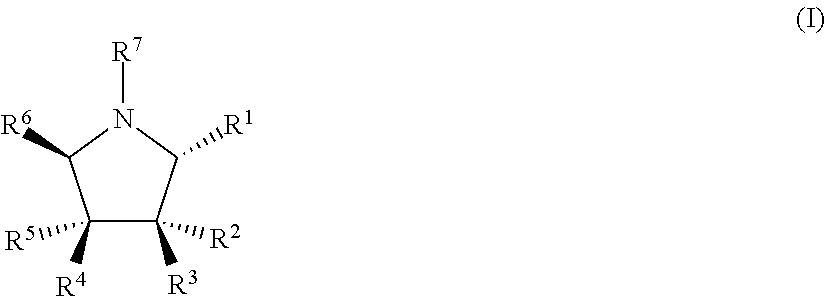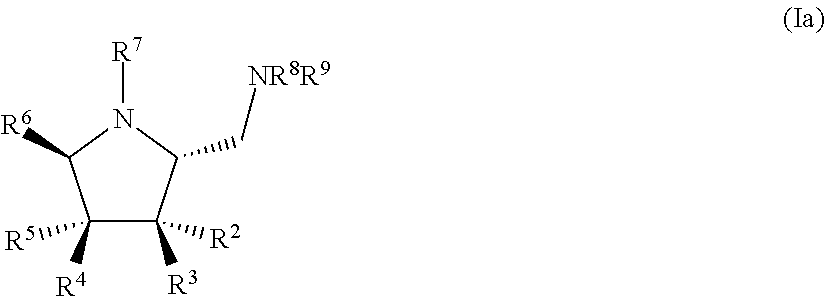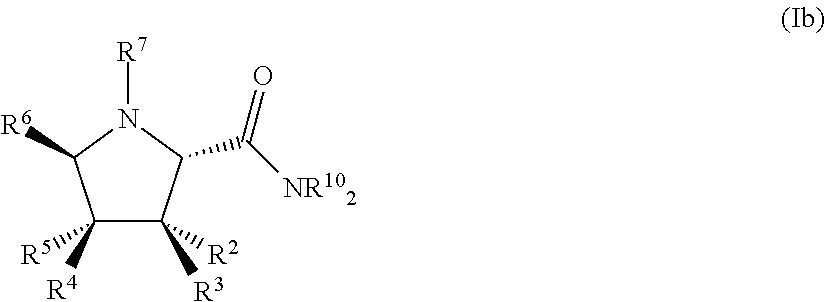Glycosidase inhibitors and uses thereof
a technology of glycosidase and inhibitors, applied in the field of glycosidase inhibitors, can solve the problems of complex use of non-selective inhibitors in studying the physiological role of cellular and organismal enzymes, hyperphosphorylation of tau, and disruption of normal functions of tau, etc., to achieve enhanced selectivity, enhanced permeability, and enhanced permeability
- Summary
- Abstract
- Description
- Claims
- Application Information
AI Technical Summary
Benefits of technology
Problems solved by technology
Method used
Image
Examples
example 1
N-(((2R,3R,4R,5R)-3,4-dihydroxy-5-(hydroxymethyl)-1-(3-phenylpropyl)pyrrolidin-2-yl)methyl)acetamide
[0251]
[0252]N-(((2R,3R,4R,5R)-3,4-dihydroxy-5-(hydroxymethyl)-1-(3-phenylpropyl)pyrrolidin-2-yl)methyl)acetamide was prepared using the general procedure for reductive amination, using hydrocinnamaldehyde. Very pale yellow oil. Yield 50%. 1H NMR (400 MHz, CD3OD) δ 7.26-7.20 (m, 4H), 7.16-7.13 (m, 1H), 3.98-3.97 (m, 1H), 3.79-3.78 (m, 1H), 3.73 (dd, J=5.0, 11.3 Hz, 1H), 3.65 (dd, J=3.3, 11.3 Hz, 1H), 3.48 (dd, J=3.5, 13.6 Hz, 1H), 3.17 (dd, J=7.0, 13.6 Hz, 1H), 3.07-3.01 (m, 2H), 2.80-2.76 (m, 1H), 2.74-2.64 (m, 2H), 2.64-2.58 (m, 1H), 1.94 (s, 3H), 1.92-1.84 (m, 2H); 13C NMR (100 MHz, CD3OD) δ 173.65, 143.71, 129.57, 129.46, 126.88, 81.26, 81.08, 70.48, 69.44, 60.82, 47.59, 39.59, 34.70, 31.25, 22.81. MS, (ES, m / z) [M+H]+ 323.21.
example 2
N-(((2R,3R,4R,5R)-3,4-dihydroxy-5-(hydroxymethyl)-1-(3-(4-methoxyphenyl)propyl)pyrrolidin-2-yl)methyl)acetamide
[0253]
[0254]N-(((2R,3R,4R,5R)-3,4-dihydroxy-5-(hydroxymethyl)-1-(3-(4-methoxyphenyl)propyl)pyrrolidin-2-yl)methyl)acetamide was prepared using the general procedure for reductive amination, using 3-(4-methoxyphenyl)propionaldehyde. Colorless oil. Yield 48%. 1H NMR (500 MHz, CD3OD) δ 7.13-7.11 (m, 2H), 6.82-6.80 (m, 2H), 3.98-3.97 (m, 1H), 3.79-3.78 (m, 1H), 3.75 (s, 3H), 3.72 (dd, J=5.1, 11.3 Hz, 1H), 3.65 (dd, J=3.3, 11.3 Hz, 1H), 3.48 (dd, J=3.2, 13.6 Hz, 1H), 3.15 (dd, J=7.0, 13.6 Hz, 1H), 3.05-3.00 (m, 2H), 2.78-2.73 (m, 1H), 2.70-2.62 (m, 2H), 2.57-2.51 (m, 1H), 1.95 (s, 3H), 1.88-1.79 (m, 2H); 13C NMR (125 MHz, CD3OD) δ 173.66, 159.39, 135.61, 130.46, 114.82, 81.23, 81.04, 70.39, 69.34, 60.74, 55.72, 47.51, 39.48, 33.75, 31.36, 22.80. MS, (ES, m / z) [M+H]+ 353.21.
example 3
N-(((2R,3R,4R,5R)-1-(3-([1,1′-biphenyl]-4-yl)propyl)-3,4-dihydroxy-5-(hydroxymethyl)pyrrolidin-2-yl)methyl)acetamide
[0255]
[0256]To a solution of [1,1′-biphenyl]-4-carbaldehyde (1.82 g, 10.0 mmol) and (carbomethoxymethyl)-triphenylphosphonium bromide (8.30 g, 20.0 mmol) in DCM (100 mL) and water (80 mL) was added NaOH (2 N, 10 mL, 20 mmol). After the mixture was stirred at room temperature for 3 h, the organic layer was collected and the aqueous was extracted with DCM (2×30 mL). The combined extract was dried over anhydrous Na2SO4. After filtration the solvent was evaporated under reduced pressure, and the residue was purified on silica gel by automatic flash column chromatography (DCM / hexanes, 1:2 to 2:1) to afford (E)-methyl 3-([1,1′-biphenyl]-4-yl)acrylate as a white solid (2.00 g, 84%). 1H NMR (500 MHz, CDCl3) δ 7.74 (d, J=16.0 Hz, 1H), 7.64-7.59 (m, 6H), 7.48-7.44 (m, 2H), 7.40-7.36 (m, 1H), 6.48 (d, J=16.0 Hz, 1H), 3.83 (s, 3H).
[0257]A suspension of (E)-methyl 3-([1,1′-biphenyl...
PUM
| Property | Measurement | Unit |
|---|---|---|
| Stress optical coefficient | aaaaa | aaaaa |
Abstract
Description
Claims
Application Information
 Login to View More
Login to View More - R&D
- Intellectual Property
- Life Sciences
- Materials
- Tech Scout
- Unparalleled Data Quality
- Higher Quality Content
- 60% Fewer Hallucinations
Browse by: Latest US Patents, China's latest patents, Technical Efficacy Thesaurus, Application Domain, Technology Topic, Popular Technical Reports.
© 2025 PatSnap. All rights reserved.Legal|Privacy policy|Modern Slavery Act Transparency Statement|Sitemap|About US| Contact US: help@patsnap.com



